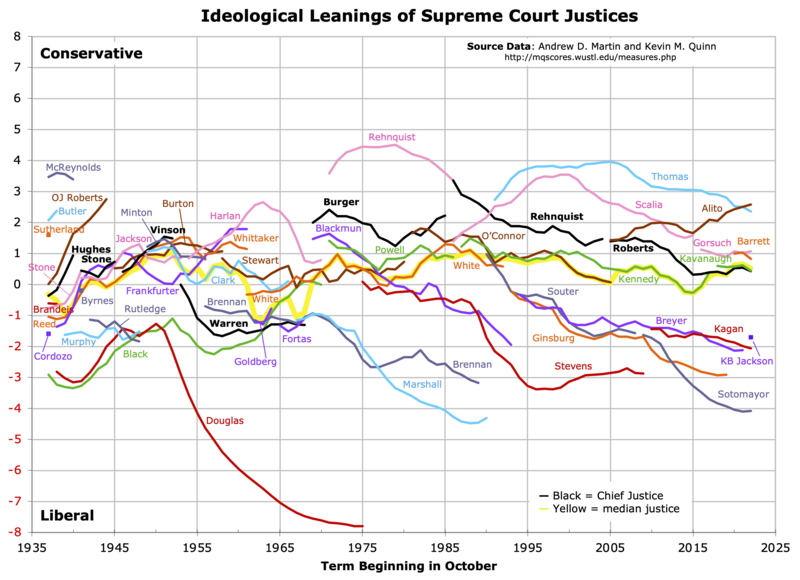How US Supreme Court will change in the hands of Conservative Justices?
The United States Supreme Court is the highest federal court of the United States. Established pursuant to Article Three of the United States Constitution in 1789, it has ultimate (and largely discretionary) appellate jurisdiction over all federal courts and state court cases involving issues of federal law plus original jurisdiction over a small range of cases. Supreme Court is the final interpreter of federal law including the United States Constitution.
The court normally consists of the Chief Justice of the United States and eight associate justices who are nominated by the president and confirmed by the Senate. The justices of the Court are often categorized as having conservative, moderate, or liberal philosophies of law and of judicial interpretation. It has long been commonly assumed that a justice's votes reflect his or her judicial decision-making philosophy as well as their ideological leanings, personal attitudes, values, political philosophies, or policy preferences. Following graph is the ideology leaning of US Supreme Court justices since 1935 by Andrew D. Martin and Kevin M. Quinn.
It shows that except Willian O. Douglas (who clearly lean to Liberal), most Justices stayed in middle of the spectrum.
Before Ruth Bader Ginsburg died of cancer in 2020, RBG led the liberal wing of Supreme Court which consists 4 Justices, and Chief Justice John Roberts swing votes between Liberal and Conservative.
Ruth Bader Ginsburg was nominated by President Bill Clinton on June 14 1993. She died 15 September 2020 as a result of Cancer. Her dead created vacancy in associated justice position, which is most likely to fill by US President Donald Trump before end of his term in 2020. Trump said in September that his Justice nominee will most likely be a woman. President Trump appointed 3 Justices
The Supreme Court decisions have the greatest impact on the governments and the laws that find violations of the Constitution, called “constitutional invalidations.” Ginsburg’s replacement will almost certainly represent one of the three biggest ideological shifts on the court since 1953. Nomination and appointment of new conservative justice will shift the balance of power in Supreme Court to conservative side, with 6-3 conservative majority. Following are the ways the Supreme Court will change in coming years.
A Broader Docket
The court takes only cases the justices choose to hear. Five votes on the nine-member court make a majority, but four is a number required to take a case to the court.
With six conservatives on the court, that would change. More certain of the outcome, the court would likely take up a broader range of divisive cases. These include many gun regulations that have been challenged as a violation of the Second Amendment, and the brewing conflicts between gay rights and religious rights that the court has so far sidestepped. They also include new abortion regulations that states will implement in anticipation of legal challenges and a favorable hearing at the court. The 3 liberal justices would no longer be able to insist that a case be heard without participation from at least one conservative, effectively limiting many controversies from consideration at the high court.
Rights Reformation
The court has grounded several expanded rights, especially the right to privacy. The government has to apply the same laws to everyone without arbitrary actions. From the conservative perspective, courts have expanded the meaning of “due process” and “liberty” beyond their legitimate border. But LGBTQ rights will not expand further. The decision that made Justice Anthony Kennedy famous for his support of gay rights, culminating in marriage equality in 2015, will advance no further. Also further claims against the constitutionality of the death penalty will not. Cases to outlaw capital punishment under the Eighth Amendment’s will also ceased.
There will be no more challenges to voting restrictions. The Bill of Rights does not protect voting rights clearly, leaving voting regulations to state legislatures. The conservative court will likely allow a broader range of restrictive election regulations, which may include barring felons from voting. It may also limit the census enumeration to citizens, effectively reducing the congressional power of states that have large noncitizen immigrant populations.
Birthright Citizenship
In the late 19th century, the U.S. Supreme Court endorsed an expansive view of birthright citizenship – that people born in a country are automatically citizens of that nation. In an 1898 ruling, the court decreed that the children of immigrants were citizens, regardless of their parents’ ancestry. Those who seek to be naturalized or people born overseas with at least one parent who is a U.S. citizen too, may claim U.S. citizenship. Similarly, children from other countries who are adopted by U.S. citizens become citizens themselves when adoption is finalized. But the court has never rule that anyone born on U.S. soil is automatically a citizen. It has always been silent on the question of children born of unauthorized residents.
The conservative understanding of the 14th Amendment is that it had no intention of granting birthright citizenship to those who are in the country without legal authorization.


Comments
Post a Comment